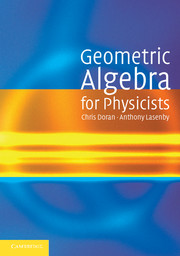Book contents
- Frontmatter
- Contents
- Preface
- Notation
- 1 Introduction
- 2 Geometric algebra in two and three dimensions
- 3 Classical mechanics
- 4 Foundations of geometric algebra
- 5 Relativity and spacetime
- 6 Geometric calculus
- 7 Classical electrodynamics
- 8 Quantum theory and spinors
- 9 Multiparticle states and quantum entanglement
- 10 Geometry
- 11 Further topics in calculus and group theory
- 12 Lagrangian and Hamiltonian techniques
- 13 Symmetry and gauge theory
- 14 Gravitation
- Bibliography
- Index
13 - Symmetry and gauge theory
Published online by Cambridge University Press: 05 January 2013
- Frontmatter
- Contents
- Preface
- Notation
- 1 Introduction
- 2 Geometric algebra in two and three dimensions
- 3 Classical mechanics
- 4 Foundations of geometric algebra
- 5 Relativity and spacetime
- 6 Geometric calculus
- 7 Classical electrodynamics
- 8 Quantum theory and spinors
- 9 Multiparticle states and quantum entanglement
- 10 Geometry
- 11 Further topics in calculus and group theory
- 12 Lagrangian and Hamiltonian techniques
- 13 Symmetry and gauge theory
- 14 Gravitation
- Bibliography
- Index
Summary
The fundamental forces of nature can all be described in terms of gauge theories. Not long after the advent of quantum theory, physicists realised that electromagnetic interactions arise from demanding invariance of quantum wave equations under local changes of phase. This idea was later extended by Yang and Mills, who showed how to construct theories based on more complicated, non-commutative Lie groups. This is the basis for the standard model of the electroweak and strong interactions. Around this time physicists also turned their attention to gravitation, and discovered that general relativity could also be formulated as a gauge theory. But this time there was a price to pay. The existence of spinor fields means that the simple geometric structure of general relativity has to be modified by the inclusion of a torsion field, leading to an Einstein–Cartan theory. For clarity, we use the term general relativity to refer to the theory defined by Einstein, with zero torsion and the connection given by the Christoffel symbol. The extended theory, with torsion present, is referred to as Einstein–Cartan theory.
While gauge theory is the dominant method in particle physics, it is less popular as a means of analysing gravitational interactions. This is, in part, due to the perception that the gauge theory equations are more complicated than their geometric counterparts.
- Type
- Chapter
- Information
- Geometric Algebra for Physicists , pp. 448 - 496Publisher: Cambridge University PressPrint publication year: 2003



